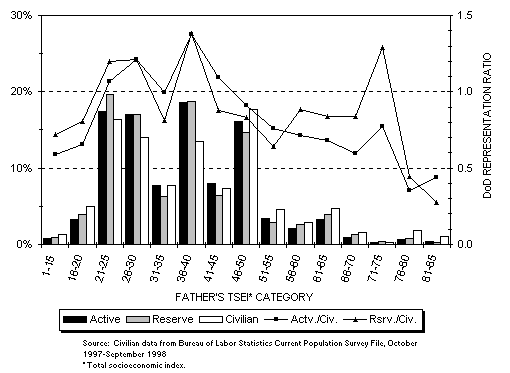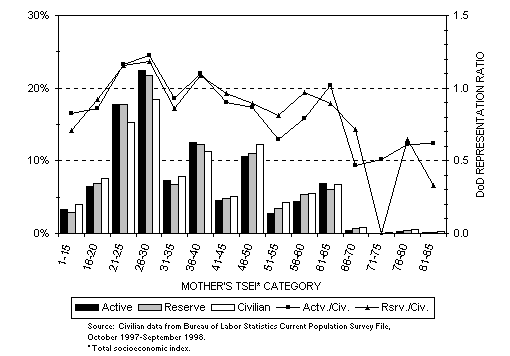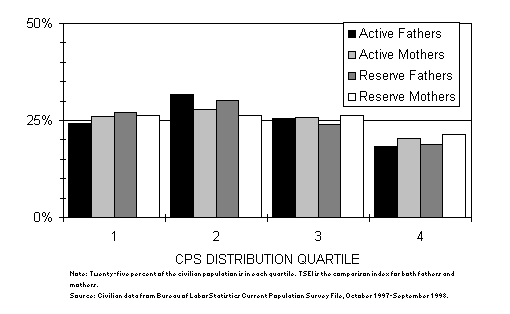|
Socioeconomic Index Scores. Socioeconomic index
scores reflecting the education, income, and prestige associated with individual occupations were computed from responses to DoD and CPS surveys. We used a common scale, the TSEI(30), to indicate occupation prestige for both fathers and mothers.The TSEI scores ranged from 10
to 81 for both DoD and CPS fathers. Figure 7.1 shows the distribution of TSEI scores for active duty, Reserve Component, and CPS fathers. In addition, the figure shows the Active and Reserve Component
representation ratios for each of the TSEI categories. For any range of TSEI scores, this number is the ratio of the percentage of DoD fathers (either active duty or Reserve Component) in the range to the
percentage of CPS fathers in the range. A representation ratio of greater than 1.0 for any TSEI category indicates a greater proportion of DoD parents in the category, compared to CPS parents, while a ratio of
less than 1.0 indicates fewer DoD parents in the category, compared to CPS parents. The magnitude of the representation ratio indicates the extent to which the DoD and CPS distributions differ.
 |
Figure 7.1. TSEI distribution for DoD and CPS fathers with DoD representation ratio.
With one exception, the representation ratios for active duty and Reserve Component fathers were very close; consequently, they will be described together.
DoD fathers were underrepresented in the lowest two TSEI categories. This range of scores includes low-status service occupations, as well as some machine
operators. The range of TSEI scores from 21 to 50 included over three quarters of the CPS fathers and 85 percent of DoD fathers. This difference produces a
representation ratio of 1.1, indicating a slightly larger proportion of DoD fathers than CPS fathers in this range. For TSEI scores between 51 and 75, DoD representation
decreased. It averages approximately 0.8 over the range, which encompasses 11 percent of DoD fathers and 14 percent of CPS fathers. DoD representation was
lowest for the two highest TSEI categories; one percent of DoD fathers and 3 percent of CPS fathers were included in these categories. Thus, enlisted accessions
tend to have fathers with occupations in the middle of the TSEI distribution, with both the high and low extremes underrepresented.
Mothers' TSEI scores ranged from 7 to 81 for both DoD and CPS mothers. As was the case with fathers, the TSEI distribution was similar for Active and Reserve
Components. As shown in Figure 7.2, the pattern of results for mothers is similar to the pattern for fathers shown in Figure 7.1. DoD mothers were underrepresented in
both the lowest two and highest four TSEI categories, with representation ratios of approximately 0.8 and 0.6, respectively. In the range of TSEI between 21 and 65,
the distribution of DoD mothers matched the distribution of CPS mothers, although it decreased slightly over this range. Overall, this range represented 87 percent of
CPS mothers and 89 percent of DoD mothers, for a representation ratio of slightly greater than 1.0. Since the Survey of Recruit Socioeconomic Backgrounds excludes
officer accessions, it would be expected to understate the average status of DoD parents.
 |
Figure 7.2. TSEI distribution for DoD and CPS mothers with DoD representation ratio.
Although both DoD mothers and fathers were underrepresented in high-status occupations, as measured by the TSEI scales, these occupations represent only a
small portion of the overall TSEI distribution in the general population. Figure 7.3 shows the representation of DoD parents from each quartile of the general
population. As the quartiles divide CPS parents into equal fourths with regard to TSEI, DoD parents would also be equally divided among the quartiles if they were
represented equally at all levels of TSEI. Figure 7.3 shows that the highest quartile of the TSEI distribution was underrepresented among enlisted accessions. The deficit
in the fourth quartile was compensated for by an excess in the second quartile, while the first and third quartiles were accurately represented. There were no substantial
differences between mothers and fathers or between active duty and Reserve Component accessions. Thus, there is no indication that enlisted personnel are drawn primarily from the lowest social strata.
In summary, enlisted accessions come from all socioeconomic levels. However, there is a tendency for accessions to come from families in the lower three-quarters
of the status distribution. These differences are expressed in the occupations of the parents of accessions, as well as discrepancies in education and home ownership.
No systematic differences were discovered between active duty and Reserve Component accessions. Including officer accessions in the analysis would be
expected to increase the representation of higher social strata among military accessions, but would probably not eliminate differences between DoD and CPS parents.
 |
Figure 7.3. DoD TSEI distribution related to CPS distribution quartiles.
 Go to next
. Go to next
.
|